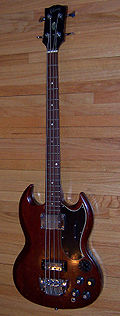
Gibson EB-3
Encyclopedia

Electric guitar
An electric guitar is a guitar that uses the principle of direct electromagnetic induction to convert vibrations of its metal strings into electric audio signals. The signal generated by an electric guitar is too weak to drive a loudspeaker, so it is amplified before sending it to a loudspeaker...
bass guitar
Bass guitar
The bass guitar is a stringed instrument played primarily with the fingers or thumb , or by using a pick....
model produced by the Gibson Guitar Corporation
Gibson Guitar Corporation
The Gibson Guitar Corporation, formerly of Kalamazoo, Michigan and currently of Nashville, Tennessee, manufactures guitars and other instruments which sell under a variety of brand names...
.
Introduced in 1961, the EB-3 (based on an earlier model, the EB-1)was one of the bass guitar equivalents of the popular Gibson SG
Gibson SG
At the launch of the SG in 1961, Gibson offered four variants of the SG; the SG Junior , the SG Special, the SG Standard, and the top-of-the-line SG Custom. However, Gibson's current core variants as of 2010 are the SG Standard and the SG Special...
. It featured a slim SG-style body, a short 30.5" scale, and two pickups (one large humbucking
Humbucker
A humbucker is a type of electric guitar pickup, first patented by Seth Lover and the Gibson company, that uses two coils, both generating string signal. Humbuckers have higher output than a single coil pickup since both coils are connected in series...
pickup in the neck position and one mini-humbucker
Mini-humbucker
The mini-humbucker is a humbucking guitar pickup originally created by The Epiphone Company. This pickup resembles a small Gibson PAF humbucker although, it is constructed differently and produces clearer, brighter tones that are quite unlike typical Gibson sounds, and fits well between single...
pickup in the bridge position). The electronics consisted of a four-way switch and associated volume and tone knobs for each pickup. The standard finish was cherry red (like the SG guitar models), though EB-3s were also produced in other finishes such as Polaris White, Pelham Blue, and ebony.
The design of the bass guitar changed several times during the 1960s. In 1962, the black plastic cover on the neck pickup was replaced by a metal one. Around 1964/5, nickel plated hardware was replaced by chrome plated. Around 1966/7 the neck was replaced with a thinner one; the unadjustable bar bridge was replaced by a fully adjustable one with a nylon saddle for each string; the string guard was removed; a bridge guard was introduced and the knobs were replaced with the witch-hat design. In 1969 and 1970, the headstock was replaced with a slotted one(similar to those on most classical guitars), with tuning keys mounted at ninety degrees downwards behind the head. In the 1970s, the position of the pickups on the body was changed and moved closer to the bridge, and different materials were used for the body and the neck. In addition to the Gibson EB-3, a long-scale (34") model, called the EB-3L, was introduced for players who preferred the longer 34" scale as featured on most Fender bass models). The EB-3 was discontinued in the late-1970s, though according to Gibson the current SG Standard Bass is its "spitting image."
Epiphone
Epiphone
The Epiphone Company is a musical instrument manufacturer founded in 1873 by Anastasios Stathopoulos. Epiphone was bought by Chicago Musical Instrument Company, which also owned Gibson Guitar Corporation, in 1957. Epiphone was Gibson's main rival in the archtop market...
produces both a more affordable EB-3 similar to the original.
Notable EB-3 players
One notable player is Jack BruceJack Bruce
John Symon Asher "Jack" Bruce is a Scottish musician and songwriter, respected as a founding member of the British psychedelic rock power trio, Cream, for a solo career that spans several decades, and for his participation in several well-known musical ensembles...
, who switched from a Fender VI to an EB-3 before the recording of Cream
Cream (band)
Cream were a 1960s British rock supergroup consisting of bassist/vocalist Jack Bruce, guitarist/vocalist Eric Clapton, and drummer Ginger Baker...
's Disraeli Gears
Disraeli Gears
Disraeli Gears is the second album by British supergroup Cream. It was released in November 1967 and went on to reach #5 on the UK Albums Chart. It was also their American breakthrough, becoming a massive seller there in 1968, reaching #4 on the American charts...
. Apparently, Bruce's bass, which he played for a decade, had a non-standard neck.

